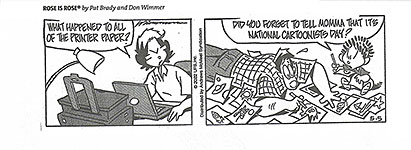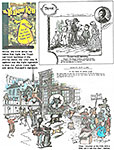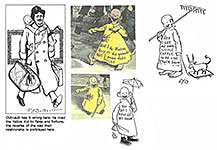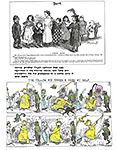 |
||
Opus 428a (May 5, 2022): Without preamble or drum-beat, all of a sudden today, here’s Rose Is Rose casually announcing National Cartoonists Day. What? When did that happen? And how? Herewith, we explain (completely albeit tediously, as is our wont)—:
NATIONAL CARTOONISTS DAY AGAIN Readers of the
comic strip Rose Is Rose on May 5 were doubtless puzzled. And so, no
doubt, were cartoonists. National Cartoonists Day? May 5? What’s going on here? Well, it’s true. Sometime in 2000, the National Cartoonists Society proclaimed May 5 as National Cartoonists Day. Why May 5? Because of the Yellow Kid. The Yellow Kid is often cited as the first newspaper comic strip character. That’s wrong: he wasn’t the first. But he was close and he was popular, and he changed the history of newspaper journalism. The
character who would later become the Yellow Kid first appeared on the scene in
a minor supporting role in cartoon panels published in Truth magazine in
1894 and 1895. One of the four different black-and-white single panel cartoons
was reprinted on 17 February 1895 in Joseph Pulitzer's New York World, where
coincidentally the cartoonist who first drew the Yellow Kid and freelanced
cartoons to Truth, Richard Outcault, worked as a technical drawing
artist. The World published another, newer Yellow Kid cartoon less than a month later, and this was followed by the strip's first color printing on 5 May 1895. The Kid inhabited a slum setting which was entitled Hogan's Alley, and it gradually became a full-page Sunday color cartoon with the Yellow Kid as its lead character. But not right away. The Kid didn’t appear again in Hogan’s Alley for about six months after the 5 May debut in color. But with his subsequent appearances, the Kid asserted his popularity with readers. The Kid was attired invariably in a nightshirt, which, at first, was blemished by handprints on front where the Kid had doubtless wiped his dirty hands; later, the nightshirt bore the Kid’s thoughts for the day, acting as a speech balloon. No one, to my knowledge, has ever devised this alternative means of conveying speech or thought; just Outcault.
The Kid soon became the principal combatant in a circulation war being waged by Pulitzer’s World and William Randolph Hearst’s New York Journal. Hearst, a recent arrival in New York’s newspaper environs, saw how popular the Yellow Kid was, so, as was his usual practice, he hired Outcault away from the World to produce the Yellow Kid for the Journal. Meanwhile, Pulitzer hired another cartoonist to continue the Yellow Kid in the World. Suddenly, the Yellow Kid was appearing in New York’s two biggest circulation newspapers. The Yellow Kid was so popular with readers that both newspapers used his image to promote the sale of their papers. The Yellow Kid appeared poster-size on the sides of newspaper delivery trucks for both newspapers. The citizenry of New York, watching this parade of Yellow Kids up and down the streets, called the newspapers “the Yellow Kid papers.” From this christening, a new term in American journalism emerged. Both the Journal and the World indulged in sensational reportage—screaming headlines, bold-face typography—in order to attract buyers/readers away from their competition. From “the Yellow Kid papers” to “the yellow papers” to “yellow journalism” (the sensational kind) it was but a short step. Outcault mused about his creation in a 1902 interview: “The Yellow Kid was not an individual but a type,” he said. “When I used to go about the slums on newspaper assignments, I would encounter him often, wandering out of doorways or sitting down on dirty doorsteps. I always loved the Kid. He had a sweet character and a sunny disposition, and was generous to a fault. Malice, envy or selfishness were not traits of his, and he never lost his temper.” The Kid’s actual name was Mickey Dugan, but after a few weeks of his appearing in a yellow nightshirt, he became, in common parlance, “the Yellow Kid.” In this elaborate history, we find obvious the reason for 5 May being National Cartoonists Day. The Yellow Kid is a significant figure in the history of newspapers and, hence, in the history of newspaper comics: his presence in a newspaper boosted circulation. He was, in other words, of commercial value to a newspaper. Thus, the Yellow Kid demonstrated the power of newspaper comics. With the Yellow Kid showing the way, newspaper comics generally were popular enough with readers to increase sales. It was logical, then, for NCS to use an association with the Yellow Kid in newspaper comics history as a means of celebrating newspaper comics and their cartoonists. And 5 May was a crucial date in the Yellow Kid’s history: it is the date of the Yellow Kid’s first appearance in color. Hence, that date marks the character’s authentic debut with the color of his nightshirt determining his name. Or so the story goes. Actually, as we’ve seen in the 5 May cartoon posted hereabouts earlier, the Kid’s nightshirt was not yellow; it was faded blue. It took a while before the nightshirt was dependably yellow every time the Kid appeared. But 5 May was still important in the history of newspaper comics. The original strategy in adopting a date to celebrate cartooning and cartoonists was that on 5 May every year, newspaper cartoonists would do exactly what Pat Brady and Don Wimmer did this year in Rose Is Rose: incorporate mention of National Cartoonists Day in their strips and panel cartoons published on 5 May. If every newspaper cartoonist did this on 5 May, cartoonists’ visibility would be enhanced beyond measure. Moreover, there would likely be newspaper stories like this one, explaining the significance of the date. More publicity. This happy outlook was almost immediately sabotaged by Steve McGarry, a Brit living and cartooning in this country who got himself elected president of NCS in 2000/2001. At NCS’s annual meeting, held in the spring of 2001 at Boca Raton, Florida, McGarry stood up to make his report to the membership. In his report was his assertion that the National Cartoonists Day effort was undermined by another celebration held every year on 5 May: Cinco de Mayo, a cultural phenomenon in the United States that celebrates Mexican culture and, for some, an opportunity to indulge in margaritas and a few cervezas, saith St.Wikipedia. Therefore, because the date 5 May was already “taken” by another organization, NCS should abandon its celebratory effort forthwith. And so it did. I was angry at this decision, which seemed to have been made by a single person, McGarry—without any discussion among the members. We had alternatives. We could have picked another date—February 17, say, the date the Yellow Kid first appeared in a newspaper, thereby paving the way for more newspaper comics. Or we could have simply ignored the coincidence with Cinco de Mayo. That’d be bad policy but it could have been done. But there was no discussion. At all. McGarry prevailed, as he often did in the ensuing years. Being president of a voluntary membership organization like NCS is not honorific: it’s a chore. It falls to the prez to do all the work of setting up the annual meeting, for example—lining up speakers and arranging for meeting rooms and the like. Any actual “work” that needs doing is done by the prez. McGarry seemed to enjoy this, and so the NCS membership let him, re-electing him at least once. He introduced several new and valuable practices and policies, but he also killed National Cartoonists Day. Or thought he’d killed it. But, as we’ve seen, Rose Is Rose has revived it. Is the revival official? Dunno: I’ve seen nothing about it in the usual NCS places. We’ll see whether the revival lasts.
To find out about Harv's books, click here. |
||

send e-mail to R.C. Harvey Art of the Comic Book - Art of the Funnies - Accidental Ambassador Gordo - reviews - order form - Harv's Hindsights - main page |



